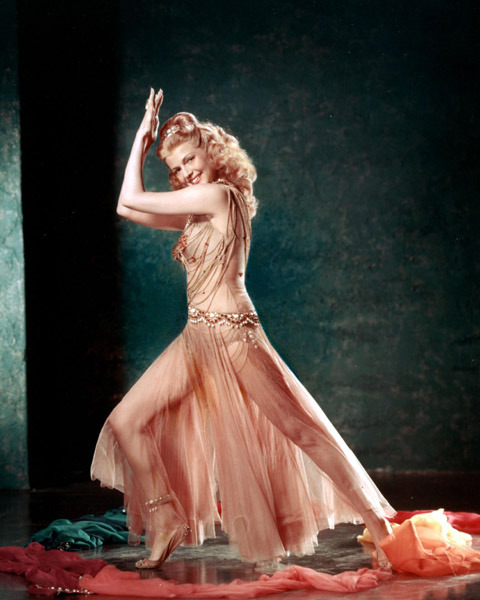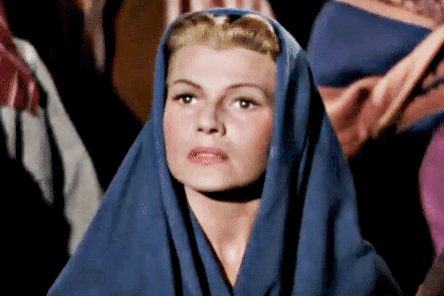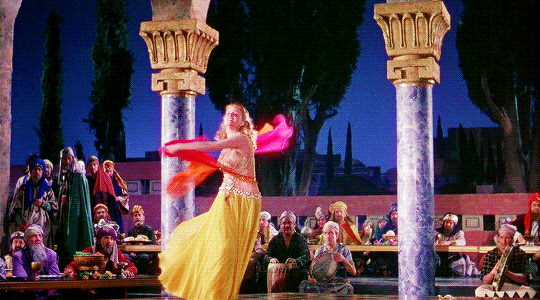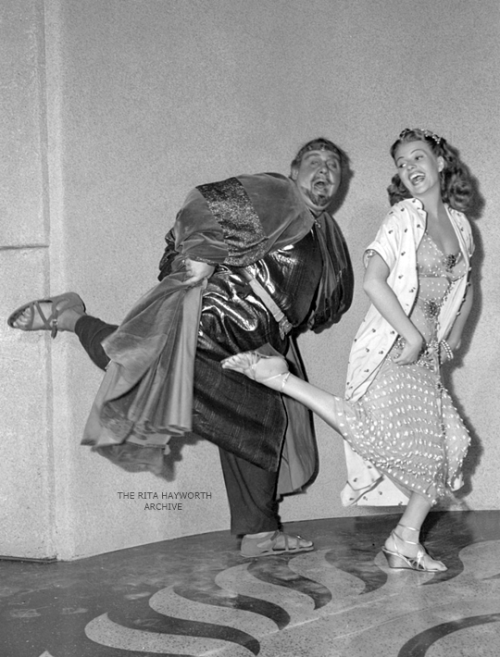ESTE
ARTIGO TEM SPOILERS
THIS
ARTICLE HAS SPOILERS
Primeiro,
ela foi Gilda, arrasando corações em um cassino em Buenos Aires em 1946.
Depois, em 1948, ela foi Carmen, uma cigana que faz um militar se tornar fora
da lei na Espanha. O próximo passo para ela foi dar vida à Salomé, que pediu a
cabeça de João Batista na Galileia. A atriz Rita Hayworth interpretou muitas femme
fatales – na lista, apenas Gilda seria considerada a femme fatale
regular do cinema noir – e ela era a escolha óbvia para interpretar a femme
fatale bíblica em “Salomé”, de 1953 – e corajosamente subverter a famosa
história.
First, she
was Gilda, wrecking hearts in a casino in Buenos Aires in 1946. Then, in 1948,
she was Carmen, a gypsy that makes an officer become an outlaw in Spain. The
next step for her was to embody Salome, who asked for John the Baptist's head
in Galilee. Actress Rita Hayworth played many femme fatales – in the list, only
Gilda could be considered the common noir femme fatale – and she was the
obvious choice to play the Biblical femme fatale in 1953's “Salome” - and
boldly subvert the well-known story.
Um pouco
do básico de história bíblica: antes de Jesus ficar conhecido como o Messias, seu
primo, João Batista, era considerado o Messias, embora sempre negasse isso. John
era alguns meses mais velho que Jesus e Jesus, já adulto, foi batizado por
João.
A little of
Biblical history 101: before Jesus became known as the Messiah, his cousin,
John the Baptist, was considered the Messiah, although he denied the title.
John was a few months older than Jesus and Jesus, already in his adulthood, was
baptized by John.
Assim como
outros profetas, João Batista (Alan Badel) prega contra tiranos, como o rei
Herodes (Charles Laughton) – o filho de Herodes o Grande, aquele rei que quis
matar todos os bebês do gênero masculino quando Jesus nasceu. Quem está mais
ansiosa com a crescente popularidade de João é a rainha Herodias (Judith
Anderson), que quer que seu marido faça algo antes que o pregador os tire do
trono.
Like other
prophets, John the Baptist (Alan Badel) preaches and talks against tyrants,
like King Herod (Charles Laughton) – the son of Herod the Great, that king who
wanted all baby boys killed by the time Jesus was born. The one more anxious
about John's growing popularity is Queen Herodias (Judith Anderson), who wants
her husband to do something about the preacher before he dethrones them.
Filha da
rainha Herodias e enteada do rei Herodes, a princesa Salomé (Rita Hayworth)
vive em Roma. Marcellus (Rex Reason), sobrinho do imperador Tiberius Cesar
(Cedric Hardwicke), quer se casar com Salomé, mas o imperador o proíbe, porque
Salomé não é romana, e então bane Salomé de Roma. No caminho para casa, ela
conhece o comandante Claudius (Stewart Granger), que deve acompanhar a caravana
dela par a Galileia. O provocador e pio comandante se apaixona por ela.
Queen
Herodias's daughter and king Herod's stepdaughter, Princess Salome (Rita
Hayworth), lives in Rome. Marcellus (Rex Reason), the nephew of emperor
Tiberius Caesar (Cedric Hardwicke), wants to marry Salome, but the emperor
forbids him to do so, because Salome is not a Roman, and banishes Salome from
Rome. On her way home, she meets commander Claudius (Stewart Granger), who must
accompany her caravan to Galilee. The provocative and pious commander falls in
love with her.
Atravessando
a planície rumo à Galileia, a caravana encontra João Batista e seus seguidores
e ocorre um confronto. Claudius impede que João seja morto por um soldado – ele
diz que a morte de João causaria revolta entre o povo, mas na realidade
Claudius e João são amigos.
When going by
land to Galilee, the caravan meets with John the Baptist and his followers and
there is confrontation. Claudius prevents John from being killed by a soldier –
he says that killing John would cause uproar among the people, but in reality Claudius
and John are friends.
No
palácio, o rei Herodes se interessa pela enteada, enquanto a rainha Herodias
cria um plano para usar a beleza de Salomé a seu favor. Salomé vai ao mercado e
ouve João Batista falando mal da mãe dela, e por isso começa a se opor a ele, o
que é perfeito para o plano de Herodias.
In the
palace, King Herod lusts over her stepdaughter, while Queen Herodias plots a
plan to use Salome's beauty to her favor. Salome goes to the market and listens
to John the Baptist speaking ill of her mother, and thus starts to oppose him,
which is perfect for Herodias's plan.
Entre 1949
e 1951, Rita Hayworth se afastou de Hollywood ao se casar com o príncipe Ali
Khan e se tornar a primeira atriz / princesa. Em 1951, DeMille disse que queria
Hayworth para interpretar Salomé em um filme que ele faria no futuro. O chefe
da Columbia, Harry Cohn, roubou a ideia e fez “Salomé” em 1953, com Hayworth
também como produtora do filme, através de sua produtora Beckworth Company, que
produziu três de seus filmes.
Between 1949
and 1951, Rita Hayworth took a break from Hollywood as she married Prince Aly
Khan and became the first actress / princess. In 1951, DeMille said he wanted
Hayworth to play Salome in an upcoming picture. Columbia boss Harry Cohn stole
the idea and made “Salome” in 1953, with Hayworth serving also as a producer,
under her company Beckworth, that produced only three of her movies.
Alan
Badel, olhando para cima o tempo todo com olhos arregalados, faz João Batista
parecer um pouco lunático. Em “Rei dos Reis” (1961), João Batista é
interpretado por Robert Ryan, o que faz com que ele pareça bem mais velho que o
Jesus de Jeffrey Hunter, e também mais circunspecto. No épico de 1961, Salomé é
interpretada por Brigid Bazlen, uma garota parecida com Elizabeth Taylor que
tinha apenas 16 anos na época.
Alan Badel,
looking up all the time with wide open eyes, makes John the Baptist look a
little bit lunatic. In “King of Kings” (1961), John the Baptist is played by
Robert Ryan, what makes him look much older than Jeffrey Hunter’s Jesus, and
also more circumspect. In the 1961 epic, Salome is played by Brigid Bazlen, an
Elizabeth Taylor lookalike who was only 16 at the time.
| John the Baptist in 1953 |
 |
| John the Baptist in 1961 |
Falando em louco, o Herodes de Charles Laughton nos lembra um pouco do Nero de Peter Ustinov em “Quo Vadis” (1951), com a diferença de que Nero era mais megalomaníaco, enquanto Herodes é mais como uma criatura nojenta. Judith Anderson, conhecida como a vilã de “Rebecca” (1940), é perfeita como a maldosa rainha Herodias.
Speaking of
crazy, Charles Laughton's Herod kind of reminds us of Peter Ustinov's Nero in
“Quo Vadis” (1951), with the difference that Nero was more megalomaniac, while
Herod is more of a disgusting creature. Judith Anderson, known as the villain
in “Rebecca” (1940), is perfect as the evil Queen Herodias.
Assim como
em “Ben-Hur”, em “Salomé” Jesus também aparece, mas seu rosto não é mostrado.
Mas, aqui, o personagem mais importante é fictício: Claudius é um homem bom
entre homens maus, dividido entre o dever e sua nova crença. Quando se apaixona
por Salomé, um novo conflito surge, pois ele tenta mostrar a ela que a mãe dela
está errada e que João Batista está pregando uma doutrina que durará séculos.
Like in
“Ben-Hur”, in “Salome” Jesus is also there, but his face is not shown. But,
here, the most important character is a fictional one: Claudius is a good man
among bad men, torn between duty and his new belief. As he falls in love with
Salome, a new conflict appears, as he tries to show her that her mother is
wrong and John the Baptist is actually preaching about something that will last
centuries.
Podemos
até ser subversivos e dizer que “Salomé” é tão subversivo quanto “Bastardos
Inglórios” (2009), de Tarantino. Salomé se redime e sua culpa no assassinato de
João Batista é apagada, e ela se torna uma vítima e não uma femme fatale.
Nesta versão, ela faz a Dança dos Sete Véus – que Hayworth mencionou como a
coreografia mais difícil que teve de fazer – como distração para que Claudius
tente libertar João Batista. Obviamente, isso não termina bem para João, mas é
bom ver Salomé como um ser humano, que ri, ama e aprende.
We can even
be subversive and say that “Salome” is as subversive as Tarantino's “Inglorious
Basterds” (2009). Salome is redeemed and her guilt in John the Baptist's assassination
is erased, and she becomes a victim rather than a femme fatale. In this
version, she performs the Dance of the Seven Veils – that Hayworth mentioned as
the most demanding dance routine she ever performed – as a distraction while
Claudius tries to free John. Of course, it doesn’t end well for John, but it’s
nice to see Salome as a human, laughing, loving and learning.
This is my
contribution to the Stewart Granger blogathon, hosted by Maddy at Maddy Loves
Her Classic Movies.










1 comment:
Gostei muito de sua análise sobre o filme. e agora consegui entender até a história de Salomé. Obrigada.
Post a Comment